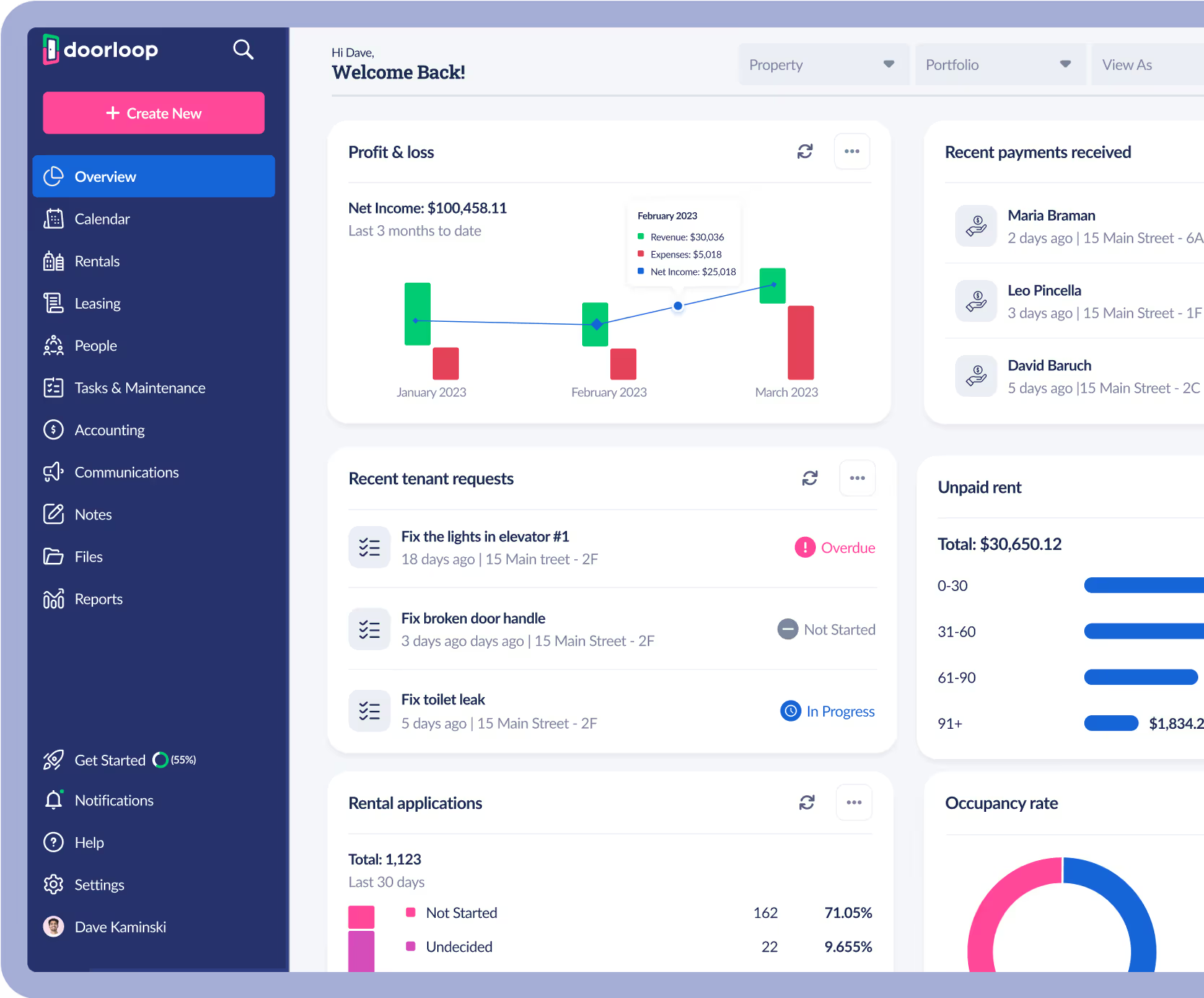When squatters choose to live in a vacant property, they move in without getting permission from the owner or landlord. This is a serious problem in the United States, and especially in Alaska. Therefore, it's important to know what you can do and how to remove squatters legally and safely. This guide will help you!
Download the Landlord’s Guide to Squatter's Rights Whitepaper

Get the quintessential guide to squatter's rights on the go from DoorLoop’s “Landlord’s Guide” series.
Click here or on the banner above to download the whitepaper and get all our best tips (by the book).
Now, let’s dive in.
Who Is a Squatter in Alaska?
Squatters typically occupy foreclosed-on, abandoned, and unoccupied buildings or lands without permission. They aren't renting and don't own the property. Though it seems illegal, it's generally not, but there are rules in place.
Isn't Squatting Called Trespassing?
Squatting might seem illegal and similar to trespassing, but it isn't. It's important to know that squatting is civil, but trespassing is considered a criminal offense. However, once a property owner or landlord establishes that the person isn't welcome, it could be treated criminally.
It's important to remember these things:
- Squatters and trespassers often make fraudulent claims, saying it's theirs so that they can remain on the property. It's illegal for them to fabricate or present false documentation to the police or owners.
- Squatters have rights, but they could get arrested as trespassers if they haven't fulfilled the adverse possession requirements.
Here are a few exceptions to prove the rule:
- Adverse possession laws only come into play when the property isn't already in use.
- If there's a legitimate emergency, the person who went on the property without permission or authorization will likely be exempt from trespassing charges.
- If the squatter beautifies an abandoned and unoccupied industrial or residential property, they might not be seen as trespassing. This includes debris removal, planting flowers, performing maintenance, and cleaning things up.
What Are Holdover Tenants?
Holdover tenants aren't considered Alaska squatters because they had been tenants who stayed at the property after the rental contract ended. They're still required to pay rent at the current terms and rates. As the landlord, you can choose to accept that without challenging anything or going to court.
However, if you serve the tenant a notice to quit and they don't leave, you can sue them for unlawful detainer. The tenant cannot claim adverse possession because they were asked to leave. Now, they are a criminal trespasser.
When you choose to accept rent, the tenant becomes a tenant at will. Therefore, they can reside at the property at your discretion, and you can evict them without notice whenever you wish.
What Are the Adverse Possession Laws in Alaska?
Squatters could claim rights to a property after residing there for a certain amount of time. When they claim adverse possession, they could gain legal ownership. This means the squatter isn't a criminal trespasser and now has legal permission to be on the property.
The adverse possession laws are clear in Alaska. The squatter must have:
- Occupied that property for 10 years through good faith, though it was a mistaken belief that this property lies within the boundary of another real property owned by the neighbor or squatter
- Occupied that property for seven years and has a color of title
The United States has five legal requirements a squatter must meet, and these have been worked into Alaska's adverse possession law. The occupation must be:
- Hostile
- Open and notorious
- Actual
- Continuous
- Exclusive
We'll discuss these at length below. Please note that all five elements must be fulfilled before the squatter can file an adverse possession claim, according to the Alaska legislature.
Continuous Possession
Squatters have to live on the property uninterrupted for seven to 10 years and must be present the whole time with the continuous possession rule. Otherwise, they cannot file an adverse possession claim.
If they do leave for a period and return to that property, the time period resets, according to the adverse possession law in Alaska.
Exclusive Possession
The exclusive possession clause indicates that the trespasser can be the only person possessing the land. Therefore, they can't share the property with the owner, other tenants, other squatters, or strangers.
Open and Notorious Possession
With this requirement, the trespasser cannot attempt to hide the occupation from anyone, which includes the property owner. Adverse possession laws are clear; it has to be obvious they live there. Otherwise, the squatter can't claim adverse possession because they're trying to obscure that fact.
Actual Possession
The actual possession requirement indicates that a trespasser must actually be physically present. They have to treat it as if they were the rightful owner. Typically, this is established by documenting maintenance efforts, showing that they made repairs and improvements, or beautifying the space by cleaning up debris and landscaping.
Hostile Claim
In legal terms, "hostile" doesn't automatically mean aggressive and violent. There are three definitions the state could use:
Awareness of Trespassing
With this rule, the trespasser is aware that they're trespassing when they use the property. They have no legal rights to it, but they wish to claim ownership anyway.
Simple Occupation
Many states follow this rule, which defines "hostile" as occupation of the land, regardless of whether they knew it belonged to another person.
Good Faith Belief
Alaska is one of the states that also include the good faith rule. It means the trespasser had a mistaken belief that they had rights to the property and could occupy it. They didn't know it belonged to another party, or they had an incorrect deed without realizing it.
Overall, the squatter is using that property in good faith and is unaware of its legal status. Alaska only recognizes a squatter operating on a good faith mistake when they've lived there for 10 years or longer.
Can Alaskans Claim Adverse Possession with a Color of Title?
Squatters in Alaska require a color of title for adverse possession unless they're in good faith, mistakenly believing that the real property is within the property boundaries of an adjacent property owned by the squatter.
Overall, a color of title means that someone "owns" the property without possessing a legal title.
A squatter could claim color of title after finishing an adverse possession claim. Alaska has certain rules to ensure landowners can retain possession unless the squatter has a reason to believe it should be theirs.
Will Squatters Pay Property Taxes?
Though many states require the squatter to prove they're paying property taxes, Alaska isn't one of them.
However, if the squatter shows that they have been paying taxes for the time they've lived on the property, it could be proof they can claim it through adverse possession.
Overall, if they paid property taxes for 10 years or longer, it's a strong case for adverse possession.
Getting Rid of Alaskan Squatters
Alaskan property owners have to use the eviction process to get rid of squatters. There are various options available, which start with the type of notice you'll serve.
It's illegal to self-evict in Alaska, even without a lease agreement. Therefore, property owners must give the person notice before the legal process begins. If a landlord shuts off the utilities, changes the locks, threatens the squatters, or removes any possessions, the squatter could sue the owner.
Sending an eviction notice is often the fastest way to remove the squatter. There are many available options, depending on your situation. These include:
- You can use a seven-day notice to pay for nonpayment of rent.
- You could issue a 30- or 14-day notice to quit since the squatter won't have a lease.
- You could send a 10-day notice to quit if the squatter won't allow you access to the building for inspections.
- You may send a 24-hour notice to quit if you can prove there's substantial damage or illegal activity on the property.
Once you've served the notice to the squatters, you can get a court date if they don't leave. Squatters rarely show up in court, and the judge will then rule in your favor. Now, you'll need to get a Writ of Assistance, allowing the State Troopers to remove squatters from your property. In many jurisdictions, local law enforcement cannot do this.
When the squatters leave personal items behind, you can keep them on the property or in a storage unit for 15 days. After that time frame, you may do what you wish with them.
Who Serves the Notice?
Regardless of the notice type you choose, it's important to allow a State Trooper or process server to serve it. You could also mail the eviction notice using registered mail, but this will extend the deadline by 72 full hours.
Conclusion - Why Use DoorLoop to Protect Yourself
It's crucial to understand what squatters are and their rights while they live in your property without paying rent. Though it's upsetting to think someone would do this, it's quite common.
Regardless, you've learned what they are and how to handle them. Make sure to follow the rules. Likewise, you can view the rental laws of Alaska and get helpful forms to download and print to send notices to squatters. DoorLoop is here to help you, making it easier to get the information necessary to protect yourself from squatters!
...And don't forget to schedule a free DoorLoop demo to see how it can revolutionize your business!
FAQs
How Do You Keep Squatters Off Your Property?
Here are a few tips to keep squatters off of your property:
- Call the State Troopers to assist.
- Ask the squatters to legally rent from you.
- Inspect your property regularly.
- Make sure you have "no trespassing" signs all around the property, especially when it's unoccupied.
- Secure your property by enclosing it, locking the windows and doors, and blocking the entrances.
- Serve a written notice once you realize you have squatters on your property.
- Hire a lawyer when you must take legal action against the squatters.
Why Should You Avoid Squatters Whenever Possible?
Squatters don't own the properties they live in. In fact, they don't get permission from the owner, so they're not paying rent and could damage the property.
Typically, squatters are expensive for landlords because they have to file paperwork with the court and go through the eviction process.
What Are Some Tips for Getting Squatters out of Your Alaskan Property?
The only way to remove a squatter from your property is to go through eviction. There are multiple eviction options available, making it easy to find the one that fits your needs and situation best.
What Does a Tenant Have to Do to File an Adverse Possession Claim?
Adverse possession can protect the tenant and let them claim rights to your property. However, they must have a color of title and occupy the property for seven years or have occupied that property for 10 years in good faith.
Likewise, there are other rules in place for adverse possession, such as:
- Hostile - No permission from the rightful owner
- Continuous - Living at the property for 10 full years
- Exclusive - No other parties occupy the property
- Open and Notorious - Not hiding the occupancy and using it as an owner would
- Actual - Exercising control over that property
Free Downloads
Resources
- https://sparkrental.com/squatters-rights/
- https://lbblawyers.com/resource/developments-alaska-adverse-possession-law/
- https://www.findlaw.com/state/alaska-law/alaska-adverse-possession-laws.html
- https://getjerry.com/home-insurance/squatter-laws-in-alaska#whos-considered-a-squatter-in-alaska
- https://ipropertymanagement.com/laws/alaska-squatters-rights
- https://www.asapcashoffer.com/blog/are-there-squatters-rights-in-alaska/
- https://www.findlaw.com/state/alaska-law/alaska-adverse-possession-laws.html













.svg)
.svg)